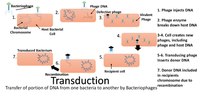
Photo from wikipedia
Engineered phage with properties optimised for the treatment of bacterial infections hold great promise, but require careful characterisation by a number of approaches. Phage–bacteria infection time courses, where populations of… Click to show full abstract
Engineered phage with properties optimised for the treatment of bacterial infections hold great promise, but require careful characterisation by a number of approaches. Phage–bacteria infection time courses, where populations of bacteriophage and bacteria are mixed and followed over many infection cycles, can be used to deduce properties of phage infection at the individual cell level. Here, we apply this approach to analysis of infection of Escherichia coli by the temperate bacteriophage 186 and explore which properties of the infection process can be reliably inferred. By applying established modelling methods to such data, we extract the frequency at which phage 186 chooses the lysogenic pathway after infection, and show that lysogenisation increases in a graded manner with increased expression of the lysogenic establishment factor CII. The data also suggest that, like phage λ, the rate of lysogeny of phage 186 increases with multiple infections.
Journal Title: Pharmaceuticals
Year Published: 2021
Link to full text (if available)
Share on Social Media: Sign Up to like & get
recommendations!